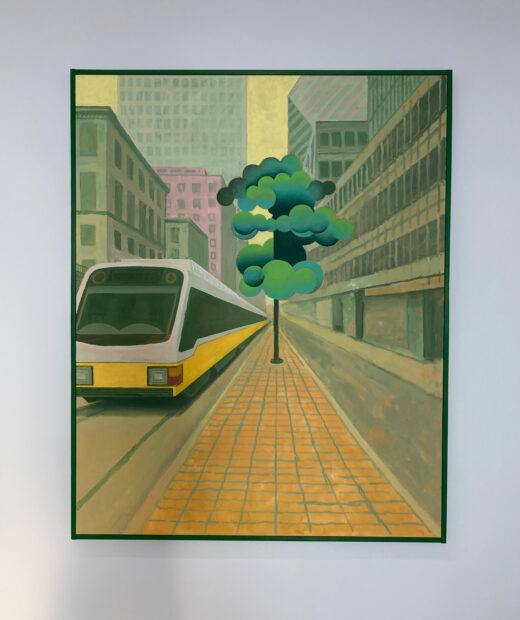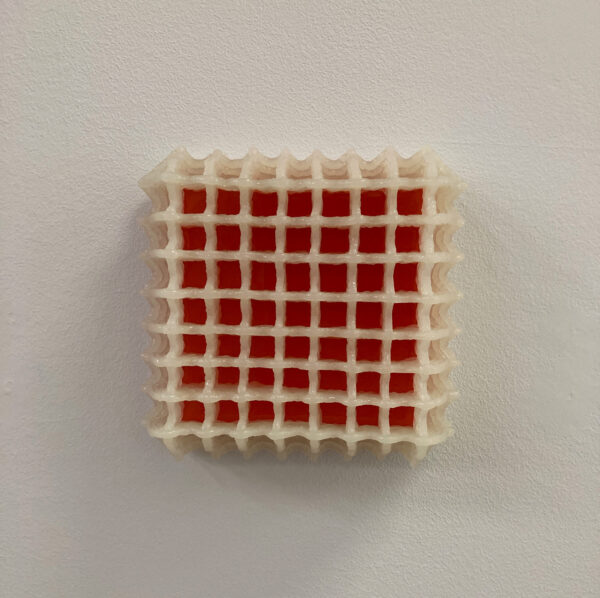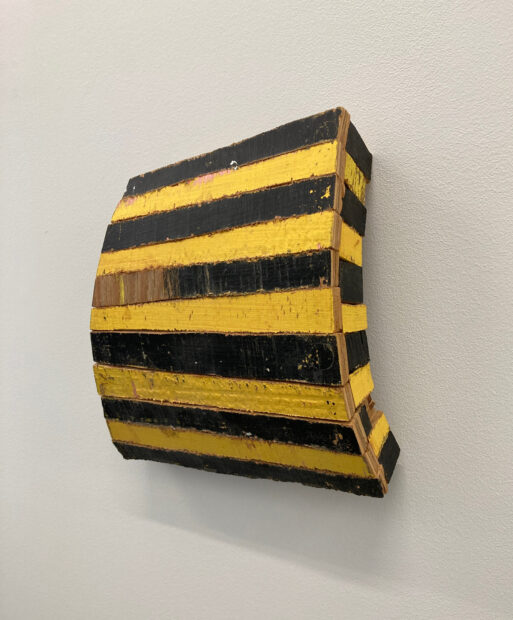
Masamitsu Shigeta, “A street car and a Tree (2),” 2023, oil on canvas with wood frame. On view at 12.26
Masamitsu Shigeta’s Reflections, on view at 12.26 in Dallas’ Design District, is a portrait of the city’s streets. Many of these scenes are of the Museum District, urban greenery, and downtown landmarks. In the space’s front gallery, there are winsome paintings in medium sizes, and in the following gallery there are miniature studies of the same images. The artist hails from Japan, though he is currently based in New York City.
When 12.26 posted their press release of the show, the first image I saw was Shigeta’s A street car and a Tree (2), whose study can be seen on the adjoining wall in the exhibition. In it, one of DART’s SLRV (Super Light Rail Vehicle) trains speeds toward the viewer from a central vanishing point. The train cars were built by Kinki Sharyo and then modified specifically for the Dallas system; they are unmistakable for another rail system. A tree sprouts from the median of a yellow brick road, tufted with green globules. The larger work is much more stylized than the study, which is true across the series.
The same night as Shigeta’s opening, down the street at SITE131, Joan Davidow gave remarks for the debut of … to see is a gift. “[This] exhibition is about… seeing and it’s about determining that something’s worth [living] with,” she said. Gift is a memorial exhibition showcasing the work of the late Seth Davidow, Joan’s son and co-founder of SITE131. The work on view here is her son’s collection, and is comprised of pieces he purchased; the collection is just part of the legacy he leaves behind as a steady patron of visual art.
Joan continued her description of this showing of art: “Because if you try to find a connection… you can’t find a continuum.” The works are too disparate. She testified that her son’s experience with art led him to collect what really struck him. As detailed within an essay by Lauren Smart, these objects lived with him, with some of them staying by his side during his final months. They are imbued with meaning because they were a part of his life.
Although it seems plausible to draw formal connections between these works (they’re all contemporary, there’s a lot of conceptual painting), that is not entirely the point of this show. Travie La Mothe’s 0427 depicts a rectangular cardboard vessel of some kind, which is splayed open as a diagram, and fits nicely in a collection of works that also includes Bret Slater’s purple and black squares in Master of Reality. Artists that have come up in Dallas, like Benjamin Terry and Arthur Peña, have works on view here from early in their careers. There is an obvious conceptualism to this grouping of works by locals: Davidow has collected artists who use material to work out their developing oeuvres. The pieces mark a robust engagement with ideas.
After SITE131, as I walked the galleries of 12.26, I knew what drew me to Shigeta’s exhibition. I travel across Texas, the United States, and sometimes outside of the country, looking at art and talking to artists and intellectuals about their work and what it means. “Texas” as a concept comes up, most frequently, in discussions about state politics, even when the discussion is happening outside of the country. I hear criticisms all the time. Seeing an artist come from another culture to chronicle Dallas, as in 12.26’s show, feels rare. My curiosity got the best of me.
Shigeta’s paintings, the larger works at least, all come in custom frames. There are scalloped edges, as in A fountain in the flower garden, and a stepped art deco header, as in The chapel of thanksgiving. For A tree tunnel (3), a wooden cage hangs on a hinge along one side of the painting, similar to Shigeta’s work that was acquired by the Dallas Museum of Art during this year’s Dallas Art Fair. Another painting shows the exterior plaza of the museum, which has a banner promoting Matthew Wong: The Realm of Appearances. This dates Shigeta’s Dallas visit to sometime before mid-February of this year.
There is a relationship between these two recently opened shows on Dallas’ west side. SITE131’s gift is an exhibition that positions an art collection as a reflection of its collector. Each work stands for the interest that it garnered from the viewer who chose to bring it home. Not all of these pieces come from Dallas, but the entire grouping owes its existence to this city. Now, we may look back at them and see what kind of aesthetics a fixture of Dallas art collecting admired and sought to keep.

Masamitsu Shigeta, “The chapel of thanksgiving,” 2023, oil on canvas with wood frame. On view at 12.26
In Reflections at 12.26, there is a view of the city’s aesthetic from the outside, cemented into individual works of art. These are objects seeking to be bought. They must appeal to the city, which does not happen often for Dallas. Much of the narrative surrounding the city involves the assassination of John F. Kennedy, which at this point was 60 years ago — hardly contemporary. Seeing Dallas validated through the eyes of a painter coming from elsewhere is moving. I make an effort to use public transit, whether to visit the library downtown for research or to view exhibitions at the same museum which has now collected Shigeta’s work. The scenes depicted here are not foreign to me.
Seeing both of these exhibitions back to back was a reminder of how many perspectives there are of the city. We can celebrate Dallas in the past and in the present with artworks, through their production or their acquisition. Art represents the place in which is was made, or sold, or that it chooses to depict, or a combination thereof. Maybe the next time I encounter street car and a Tree (2), it will be in the stairwell of a collector’s home. I’ll be looking for it.
William Sarradet is the Assistant Editor for Glasstire.





